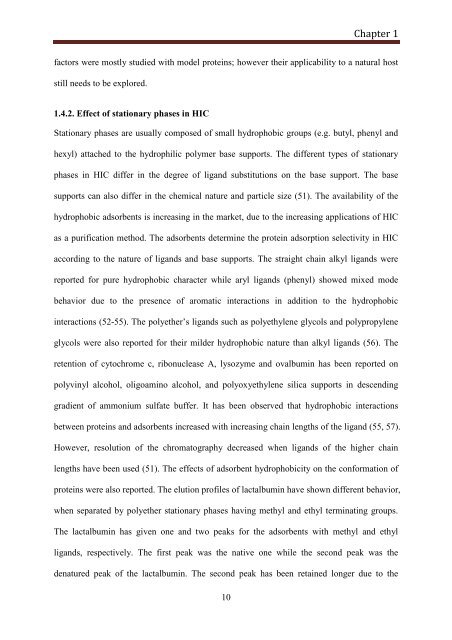Thesis final - after defense-7 - Jacobs University
Thesis final - after defense-7 - Jacobs University
Thesis final - after defense-7 - Jacobs University
Create successful ePaper yourself
Turn your PDF publications into a flip-book with our unique Google optimized e-Paper software.
Chapter 1<br />
factors were mostly studied with model proteins; however their applicability to a natural host<br />
still needs to be explored.<br />
1.4.2. Effect of stationary phases in HIC<br />
Stationary phases are usually composed of small hydrophobic groups (e.g. butyl, phenyl and<br />
hexyl) attached to the hydrophilic polymer base supports. The different types of stationary<br />
phases in HIC differ in the degree of ligand substitutions on the base support. The base<br />
supports can also differ in the chemical nature and particle size (51). The availability of the<br />
hydrophobic adsorbents is increasing in the market, due to the increasing applications of HIC<br />
as a purification method. The adsorbents determine the protein adsorption selectivity in HIC<br />
according to the nature of ligands and base supports. The straight chain alkyl ligands were<br />
reported for pure hydrophobic character while aryl ligands (phenyl) showed mixed mode<br />
behavior due to the presence of aromatic interactions in addition to the hydrophobic<br />
interactions (52-55). The polyether’s ligands such as polyethylene glycols and polypropylene<br />
glycols were also reported for their milder hydrophobic nature than alkyl ligands (56). The<br />
retention of cytochrome c, ribonuclease A, lysozyme and ovalbumin has been reported on<br />
polyvinyl alcohol, oligoamino alcohol, and polyoxyethylene silica supports in descending<br />
gradient of ammonium sulfate buffer. It has been observed that hydrophobic interactions<br />
between proteins and adsorbents increased with increasing chain lengths of the ligand (55, 57).<br />
However, resolution of the chromatography decreased when ligands of the higher chain<br />
lengths have been used (51). The effects of adsorbent hydrophobicity on the conformation of<br />
proteins were also reported. The elution profiles of lactalbumin have shown different behavior,<br />
when separated by polyether stationary phases having methyl and ethyl terminating groups.<br />
The lactalbumin has given one and two peaks for the adsorbents with methyl and ethyl<br />
ligands, respectively. The first peak was the native one while the second peak was the<br />
denatured peak of the lactalbumin. The second peak has been retained longer due to the<br />
10

















